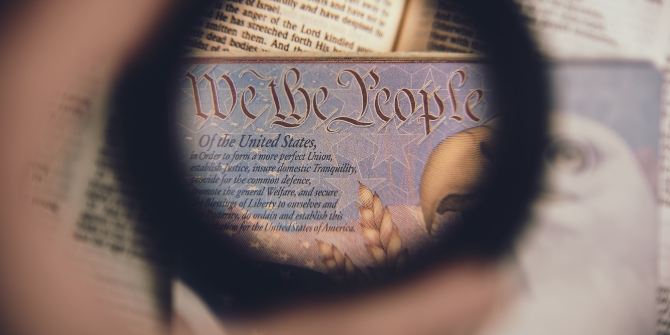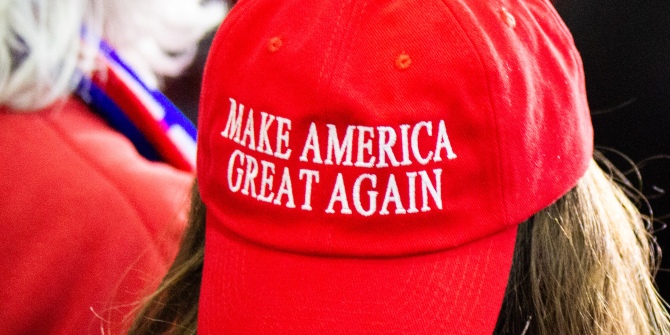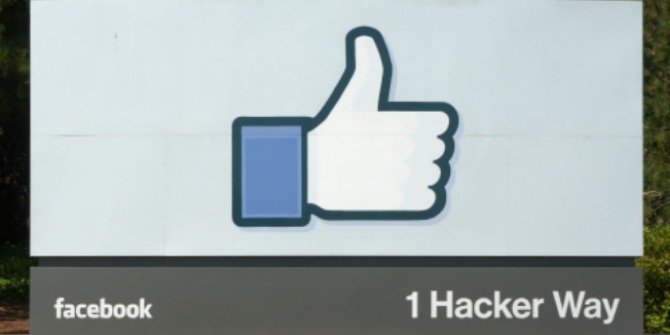 Last week, the US Supreme Court ruled that presidents are immune from prosecution for “official acts” committed while in office. While many critics have suggested that the legal reasoning behind the decision was poor, Kathleen Tipler disagrees. The Court’s opinion, she argues, reflects the difficulty of the question of presidential immunity, which requires balancing competing constitutional needs. Ultimately, it was – and is – Congress’s responsibility to check a president, and Congress’s failure to do so points to fundamental problems with the constitutional order.
Last week, the US Supreme Court ruled that presidents are immune from prosecution for “official acts” committed while in office. While many critics have suggested that the legal reasoning behind the decision was poor, Kathleen Tipler disagrees. The Court’s opinion, she argues, reflects the difficulty of the question of presidential immunity, which requires balancing competing constitutional needs. Ultimately, it was – and is – Congress’s responsibility to check a president, and Congress’s failure to do so points to fundamental problems with the constitutional order.
On Monday, July 1st, the US Supreme Court issued its decision in Trump v. United States. In it, the Court addressed the question of whether a former president is immune from criminal prosecution, and concluded, yes, presidents have some degree of immunity. The decision, written by the conservative Chief Justice John Roberts, produced cries of outrage on the left, with critics claiming the decision not only created a king who is above the law – e.g., “The Court’s Trump immunity decision is a blueprint for dictatorship,” argued a typical op-ed – but was driven by political motives, as evidenced by its supposedly poor legal reasoning.
The difficult question of presidential immunity
As a legal scholar who has been thinking about this question of presidential immunity for a number of years, my take is different. I think the decision is a reasonable opinion. I do disagree with it, but it is not because this decision puts presidents above the law – I think the Roberts opinion left the door open for prosecution of Trump, including ones that the dissenting opinions declare impossible – nor is it because this decision is based on specious legal reasoning. I disagree because of the larger approach it takes to the constitutional order.
To understand Roberts’s opinion here, it’s important to recognize how hard the question of presidential immunity is. Anyone who says there’s an obviously correct answer to the question of presidential immunity has simply not thought enough about it. It’s a hard question for at least three reasons.
One, there’s little precedent. There are a couple of earlier Court decisions that have considered presidential immunity from private lawsuits – like when Paula Jones sued (sitting) President Clinton in 1994, or when an Air Force contractor sued (former) President Nixon in 1982 – but the Court has never taken up the question of a criminal prosecution of either a former or sitting president. So, the Court, in deciding this case, is creating new standards and is necessarily engaging in at least some degree of novel legal reasoning.
Two, it’s a hard question because conceptually, from the perspective of constitutional theory, competing constitutional needs must be balanced to mark out the extent of presidential immunity. On one hand, there is the obvious and deep-seated principle that no person be above the law. Indeed, this is what the American Founders pointed to as justification for breaking from Great Britain in the 18th century – we were being subjected to the tyrannical impulses of a king who put himself above the law and violated our basic rights as Englishmen (i.e., our right to a trial by jury, right to representation, and so on). This foundational principle that no person is above the law is central to American legal-cultural norms, and it partly explains the left’s kneejerk outrage at the Court’s decision: no one should have any sort of immunity, because Americans believe that, above all else, everyone should be treated equally by the law.
On the other hand, though, from the perspective of both good governance and separation of powers theory, it’s reasonable to conclude presidents should have at least some degree of immunity from both public and private lawsuits. As the few cases that address private lawsuits against presidents emphasize, presidents are in a unique position. Unlike the legislative and judicial branches, the executive branch is led by only one person, the president. No one else can easily step in and do their job if they are distracted by a lawsuit or enmeshed in a criminal trial or imprisoned. Constitutional theorists also deduce institutional structure (e.g., the extent of presidential immunity) from institutional roles and obligations. Here, noting that the president’s explicit constitutional duties and obligations, such as Commander-in-Chief, require that a president be able to act with speed and decisiveness in national emergencies, it again seems reasonable to insulate a president from distraction with some level of immunity.

“Trump v. United States” (CC BY-NC-ND 2.0) by vpickering
In addition to the handful of cases that explicitly address immunity, there is another separation of powers principle that comes into play: executive privilege. Drawing, again, from the constitutional duties of the president (including as “chief diplomat”), courts have recognized presidents have a unique need for secrecy in communications, and should have an expectation of such secrecy, especially with their closest advisors. When considering the extent of presidential immunity, the principle of executive privilege must therefore be considered as well, as it will likely conflict with judicial proceedings’ need for evidence.
Balancing competing principles of presidential immunity
Roberts’s opinion did a reasonable job of balancing these competing principles. He developed a three-part structure of presidential actions based on the office’s constitutional duties, attributing absolute immunity to “core” constitutional duties and no immunity to unofficial acts. In the middle, the opinion created a category of “official acts” of a president which are “presumptively immune” (i.e., one must prove the appropriateness of prosecution before beginning the actual prosecution).
Roberts developed this three-part structure by turning to Justice Robert Jackson’s concurrence in a 1952 Supreme Court decision, Youngstown, which held that President Truman did not have the power to seize control of steel production. Note that concurring opinions are written by justices when they agree with the outcome of a Court decision but disagree with at least part of the majority opinion’s reasoning. Because of this, majority opinions are usually cited in future decisions, not concurrences. However, Jackson’s concurrence in Youngstown is an exception, as it laid out an elegant way of thinking through the separation of powers. While I don’t have the space here to get into the details of Roberts’ application of Youngstown, I will say that I found it creative, in a way that is, on the one hand, ingenious and justifiable, but, on the other, makes some things appear similar that are not, while ignoring similarities that don’t advance the argument.
Immediate consequences for the prosecution of Trump
One clear consequence of the decision is that it will delay the ongoing trial of former President Trump for his role in overturning the 2020 election results. This is because the prosecution must now show, with evidence that does not rely on communications protected by executive privilege, that they are prosecuting Trump for unofficial acts.
If Trump is re-elected, he will stop this process, as the election interference charges are brought by the federal government, which he would then control. Prosecutions by state government officials could continue, but they would have to show that whatever charges they bring against Trump only address his non-official duties. It’s also important to note that if Trump wins the 2024 election, Trump would have then become a sitting president, the immunity of which is not addressed in this decision. For all the reasons that I outlined above, it is very possible the Court would conclude (in a second immunity decision) that sitting presidents have greater immunity than former presidents.
Does that make this a politically motivated opinion? It is certainly possible that some or all of the six justices who signed this opinion were motivated by political goals. However, this opinion does not show blatantly contorted legal reasoning. It reflects a view of the executive branch and separation of powers that I think is incorrect, but it is not absurd, and it is not coming out of nowhere.
Furthermore, if Trump is not re-elected, the consequences of this decision are harder to divine. While the decision said that one of the charges against Trump must be dropped, it left the lower court to investigate the other charges. Notably, the opinion explicitly said that when a president acts as an electoral candidate, they are acting in a non-official capacity, i.e., actions as a candidate are not immune from prosecution. This is a pretty significant door for the prosecution to walk through, given they are charging Trump with election interference. But exactly how that would play out – and what the Supreme Court would do if it were to hear this case a second time – is unclear.
The broken American constitutional order
While I do have disagreements with some of the legal reasoning, my main issue with this decision is the approach it takes to the constitutional order as a whole. And this is the third reason the question of presidential immunity is so hard: the underlying problem is that the American constitutional order is broken in fundamental ways. Our Constitution is so, so old – 250 years old. It was not written with the modern presidency in mind. It was not written in consideration of the massive administrative state and complex bureaucracy that we have today. It was not written with any conception of modern warfare and contemporary security needs. It was not written with what political scientists call the “informal powers” of the president, including the president’s leadership of one party in a two-party system, and the persuasive powers of a president, given their unique national media presence.
While the constitutional question facing the Supreme Court in Trump v. United States was the extent of presidential immunity, the case itself involves a former president who attempted to overturn the election that voted him out of office. If the authors of the Constitution anticipated such a situation, they thought Congress would handle it – the Constitution explicitly gives Congress the power of removing the president for “high crimes and misdemeanors.” And that’s what should have happened. But instead, because of the various ways in which our country has changed over the past 250 years, Congress failed to do so.
So, this failure by Congress, this failure of the constitutional order, puts the Supreme Court in a bind. Essentially, the Court had two options here, as they often do, given our ancient Constitution: they could stay in their lane, and limit judicial review of presidential actions (broader presidential immunity, careful and slow judicial process), or they can try to make a broken system work, step in where Congress failed, and have the judiciary review presidential actions (limited or no presidential immunity, expedited judicial process). I think the latter approach is better, but the Roberts Court chose the former approach, as they have with other decisions this term, like when they overturned Chevron. That, I think, is a very risky approach. – but only time will tell its consequences.
- Please read our comments policy before commenting.
- Note: This article gives the views of the author, and not the position of USAPP – American Politics and Policy, nor the London School of Economics.
- Shortened URL for this post: https://wp.me/p3I2YF-e5f






